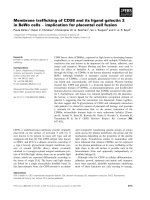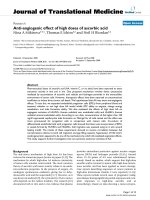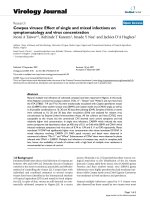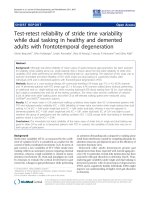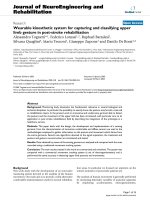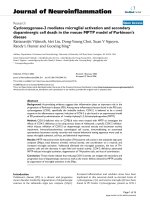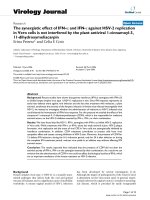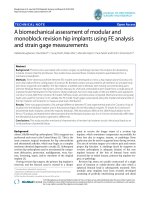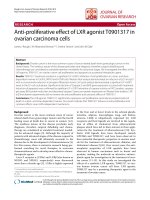Báo cáo hóa học: " The synergistic effect of IFN-α and IFN-γ against HSV-2 replication in Vero cells is not interfered by the plant antiviral 1-cinnamoyl-3, 11-dihydroxymeliacarpin" pptx
Bạn đang xem bản rút gọn của tài liệu. Xem và tải ngay bản đầy đủ của tài liệu tại đây (346.61 KB, 10 trang )
BioMed Central
Page 1 of 10
(page number not for citation purposes)
Virology Journal
Open Access
Research
The synergistic effect of IFN-α and IFN-γ against HSV-2 replication
in Vero cells is not interfered by the plant antiviral 1-cinnamoyl-3,
11-dihydroxymeliacarpin
Erina Petrera* and Celia E Coto
Address: Laboratory of Virology, Department of Biochemistry, School of Science, University of Buenos Aires, Buenos Aires, Argentina
Email: Erina Petrera* - ; Celia E Coto -
* Corresponding author
Abstract
Background: Recent studies have shown that gamma interferon (IFN-γ) synergizes with IFN-α/β
to inhibit herpes simplex virus type 1 (HSV-1) replication in vitro. Since IFN response represents an
early host defense event against viral infection and the fact that treatment with meliacine, a plant
antiviral, ameliorate the severity of the herpetic infection in female mice infected intravaginally with
HSV-2, we wanted to investigate whether the administration of meliacine to HSV-2 infected mice
could altered the homoestasis of IFNs host response. For this purpose we studied the effect of the
compound 1-cinnamoyl-3,11-dihydroxymeliacarpin (CDM), which is the responsible for meliacine
antiviral action, on the HSV-2 inhibition exerted by IFN α, IFN-γ or their combination.
Results: We have found that like HSV-1, IFN-γ synergizes with IFN-α to inhibit HSV-2 replication
in Vero cells. While treatment with IFN-α or IFN-γ alone has weak antiviral action, HSV-2 plaque
formation, viral replication and the onset of viral CPE in Vero cells are synergistically inhibited by
interferon combination. In addition, CDM treatment contributes to protect cells from virus
cytopathic effect and causes a strong inhibition of HSV-2 titer. Moreover, the presence of CDM for
2 h before IFN induction, during the 16 h induction period, only for 24 h after infection or during
the complete IFN treatment period, reduces virus yields in an additive way without affecting IFN
antiviral action.
Conclusion: The results reported here indicated that the presence of CDM did not alter the
antiviral activity of IFN-α, IFN-γ or the synergism exerted by their combination. As a result we can
envision that the administration of CDM in vivo could not affect the biological activity of IFNs, which
are so important mediators of the innate resistance to HSV-2 infection.
Background
Herpes simplex virus type 2 (HSV-2) is a sexually trans-
mitted pathogen that infects both the oral and genital
mucosa of humans and is a significant cause of morbidity
worldwide. A mouse vaginal model of HSV-2 infection
has been developed by several investigators [1-4].
Although the degree of pathogenicity of the virus for mice
is dependent on the virus strain used, in general, experi-
mental infection by vaginal route (i.v) results in neurolog-
ical disease, which is preceded by easily recognizable
Published: 13 June 2006
Virology Journal 2006, 3:45 doi:10.1186/1743-422X-3-45
Received: 06 March 2006
Accepted: 13 June 2006
This article is available from: />© 2006 Petrera and Coto; licensee BioMed Central Ltd.
This is an Open Access article distributed under the terms of the Creative Commons Attribution License ( />),
which permits unrestricted use, distribution, and reproduction in any medium, provided the original work is properly cited.
Virology Journal 2006, 3:45 />Page 2 of 10
(page number not for citation purposes)
symptoms due to inflammation followed by rear leg
paralysis and death. This mouse model provides a useful
tool to test the effect of antivirals against HSV-2 infection.
Many studies have been performed in our laboratory with
an antiviral compound isolated from the leaves of Melia
azedarach L. named meliacine (MA). We have shown that
meliacine strongly inhibited the replication of HSV-1 and
HSV-2 in Vero cells [5] and exhibits a synergistic antiviral
activity when combined with acyclovir [6]. Studies per-
formed by Alché et al suggested that MA exerts the antivi-
ral action on both synthesis of viral DNA and maturation
and progress of HSV-1 on Vero cells [7]. In vivo studies
have shown that meliacine prevents the development of
HSV-1 stromal keratitis in mice [8,9]. Likewise, the sever-
ity of the herpetic infection in female mice infected intra-
vaginally with HSV-2 was also ameliorated by MA
treatment [10]. On the other hand, besides its broad effect
of antiviral action, meliacine acts as an immunomodula-
tor in vitro agent inhibiting the phagocytosis of opsonized
sheep erythrocytes and impairing the proliferation of
spleen and lymph node T cells [11,12]. Moreover, melia-
cine is a weak inducer of tumor necrosis factor alpha
(TNF-α) in murine macrophage cultures and causes a syn-
ergistic effect on the production of TNF-α induced by LPS
[13]. Vaginal washes of female mice infected i.v. with
HSV-2 and treated with meliacine contained an increased
amount of TNF-α in comparison with infected non-
treated animals [10].
IFN response represents an early host defense event, one
that occurs prior to the onset of the immune response. In
this context, macrophages play a central role in resistance
of mice to primary infection with HSV-2, mainly, as a
source of antiviral cytokines, TNF-α, IFN α/β and IL-12,
which are produced rapidly after infection [14]. IFN-γ, a
strong activator of macrophages [15-17] is produced both
in the early stages of infection by natural killer cells and at
later stages by activated T cells [18]. The innate immune
response to viral infection depends on the integrity of this
network of cytokines, which is tightly regulated [19]. This
in vivo situation led us to query whether the administra-
tion of meliacine to HSV-2 infected mice could altered the
homoestasis of IFNs host response either affecting the
antiviral activity of IFN α/β or IFN-γ, or their synergizing
interaction [20,21]. To answer that question we con-
ducted experiments following an indirect approach based
on the observation that IFN-γ synergizes with IFN α/β to
inhibit HSV-1 replication in Vero cells [20]. To that end,
Vero cells infected with HSV-2 were treated with IFN-α,
IFN-γ or a combination of both in the presence or absence
of meliacine under different experimental conditions.
To perform these experiments instead of meliacine, we
worked with the compound 1-cinnamoyl-3,11-dihy-
droxymeliacarpin (CDM) which is the molecule responsi-
ble for the broad spectrum of meliacine antiviral action
[22]. In summary, here we analyzed: i) the susceptibility
of HSV-2 to IFN-α, IFN-γ or the combination of both in
Vero cells since no published data is available with this
herpesvirus; ii) the effect of CDM on interferons action.
Results
Antiviral effect of IFN-
α
, IFN-
γ
and IFNs combination on
HSV-2 plaque formation
Since there is no published data on the effect of IFNs on
HSV-2 infection in Vero cells the capacity of human IFN-
α and/or IFN-γ to inhibit the replication of HSV-2 strains
MS and G was initially performed in a plaque reduction
assay. The concentration of IFN-α and IFN-γ used in the
present experiment were those previously tested against
HSV-1 (KOS strain) [20]. Vero cells were pretreated for 16
hours with 100 IU/ml of IFNs separately or in combina-
tion and infected with HSV-2 (MS or G strain) at the MOI
of 1 PFU per cell. HSV-1 (KOS and F strains) were also
tested using the same MOI and served as controls. The effi-
ciency of HSV-1 strains KOS and F plaque formation was
quite modestly reduced by the presence of IFN-α or IFN-γ
alone. Whereas, the combination of IFN-α and IFN-γ
acted synergistically as previously reported for HSV-1
[20,23].
Simultaneous treatment of Vero cells with both IFN-α and
IFN-γ reduced HSV-2 plaque formation 3.8 fold for MS
strain and 8.6 fold for G strain in comparison with the
effect of each IFN alone (Table 1). Likewise HSV-1, the
level of inhibition achieved with IFN-α and IFN-γ combi-
nation treatment was not a consequence of doubling the
amount of IFN per culture. As seen in Table 1, increasing
the concentration of each IFN to 200 IU/ml did not aug-
ment the inhibitory effect.
These results indicate that HSV-2 replication in Vero cells,
as other members of the herpes virus family like HSV-1
[20], VZV [24] and CMV [25] shows an increased suscep-
tibility to IFN combination with respect to each IFN
alone.
Effect of IFN-
α
and IFN-
γ
on HSV-2 replication
To further characterize the inhibitory effect of IFN-α and
IFN-γ treatment on HSV-2 replication, three days viral
growth assay were performed. Vero cells were pretreated
for 16 h with 100 IU/ml of IFNs separately or in combina-
tion. Then, cells were infected with HSV-2 (MS or G
strain) at the MOI of 1 PFU per cell and culture superna-
tants were harvested at 24, 48 and 72 h p.i. and titered for
infectious virus. For control purpose HSV-1 strains KOS
and F similarly treated were included. In accordance with
the results presented in Table 1, we observed a greater
inhibitory effect on HSV-2 replication when Vero cultures
Virology Journal 2006, 3:45 />Page 3 of 10
(page number not for citation purposes)
were treated with IFNs combination than IFN-α or IFN-γ
alone, despite that each interferon showed a greater anti-
viral activity than in plaque reduction assay (Figure 1). In
cultures treated with 100 IU/ml of IFN-α or IFN-γ, MS and
G replication was 8-fold and 100-fold reduced respec-
tively (p < 0.001) at 24 h p.i. (Figure 1a and 1b). At 48 and
72 h p.i. viral titers in IFN-α or IFN-γ-treated cultures
approached levels of those detected in vehicle-treated
groups. However, relative to vehicle control cultures, viral
titers recovered at 48 and 72 h from cultures treated with
IFN-α or IFN-γ were reduced by 2-fold in MS-infected cul-
tures and 2-and 3-fold in G infected cultures respectively
(Figure 1e and 1f). In HSV-2 infected cultures treated with
combination of IFN-α and IFN-γ the inhibitory effect was
different between strains. Titers of HSV-2 MS were
reduced 100-fold approximately relative to vehicle treated
Vero cells at all time point tested. In the case of HSV-2 G,
IFN combination virus titers were reduced 10.000-fold in
comparison to control cultures at 24 h p.i. At 48 and 72 h
p.i. the antiviral activity decreased, however virus replica-
tion was still 2000-fold inhibited. These results indicate
that the combination of IFN-α and IFN-γ synergizes the
antiviral effect against HSV-2 in a similar mode to previ-
ously reported for HSV-1 (Figure 1c, 1d, 1g and 1h)
[23,25].
Treatment with IFN combination protects HSV-2 infected
cells from viral cytopathic effect (CPE)
Due to the long time that IFNs were in contact with cells
in the experiments just described we performed new ones
in order to discard any cytotoxicity due to the cytokines
that could affect the results observed. For that purpose cul-
tures of Vero cells were treated for 16 h with IFN-α, IFN-γ
or the combination of both. After that time, monolayers
were infected with 1 PFU per cell of HSV-2 MS strain and
fresh medium containing or not IFN was added after 1 h
virus adsorption and remained up to the end of the exper-
iment. Cell morphology was observed by light micro-
scope and the number of viable cells at 0, 12, 24, 36 and
48 h p.i. was determined by MTT colorimetric assay. In
comparison with vehicle treated uninfected cells, IFN
treatment did not affect cell morphology or proliferation.
(Figure 2a). Infection with HSV-2 MS strain destroyed
87.5% of vehicle-treated cells by 48 h p.i. (Figure 2b).
Treatment with IFN-α or IFN-γ delayed the onset of CPE
in MS-infected cultures and increased the fraction of via-
Table 1: Effect of IFN-α and IFN-γ on HSV-2 and HSV-1 plaque formation on Vero cells.
Treatment (IU/ml)
a
Mean no. of plaques
b
± SEM Fold reduction
c
HSV-2 MS Vehicle 137 ± 8.3 -
IFN-α (100) 82.5 ± 6.4 1.7
IFN-γ (100) 86 ± 6.6 1.6
IFN-α (100)+IFN-γ (100) 36.5 ± 4.3 3.8
IFN-α (200) 68 ± 5.8 2
IFN-γ (200) 72 ± 6 1.9
HSV-2 G Vehicle 98.5 ± 7 -
IFN-α (100) 81 ± 6.4 1.2
IFN-γ (100) 98 ± 7 1
IFN-α (100) + IFN-γ (100) 11.5 ± 2.4 8.6
IFN-α (200) 52 ± 5.1 1.9
IFN-γ (200) 35 ± 4.2 2.8
HSV-1 KOS Vehicle 133 ± 8.2 -
IFN-α (100) 68.5 ± 5.9 1.9
IFN-γ (100) 74.5 ± 6.1 1.8
IFN-α (100) + IFN-γ (100) 4 ± 1.4 33
IFN-α (200) 54.5 ± 5.2 2.4
IFN-γ (200) 84.5 ± 6.5 1.6
HSV-1 F Vehicle 100 ± 7.1 -
IFN-α (100) 82.5 ± 6.4 1.2
IFN-γ (100) 84.5 ± 6.5 1.2
IFN-α (100) + IFN-γ (100) 19 ± 3.1 5.3
IFN-α (200) 51.5 ± 5.1 1.9
IFN-γ (200) 53 ± 5.1 1.9
a
Vero cells were treated continuously with IFN-α, IFN-γ or combinations of these cytokines from 16 h before infection until the end of the
experiment.
b
Average number of plaques per well of Vero cells inoculated with 200 PFU of HSV-1 KOS and F and HSV-2 MS and G. Values represent (mean ±
SEM) from three independent experiments.
c
Fold-reduction in each group was calculated as follows: number of plaques in vehicle/number of plaques in treatments. Values represent mean
from three independent experiments. P < 0.05, as determined by one-way ANOVA and Turkey's post hoc t test comparison of this treatment to
vehicle.
Virology Journal 2006, 3:45 />Page 4 of 10
(page number not for citation purposes)
Effect of IFN-α and IFN-γ on HSV replicationFigure 1
Effect of IFN-α and IFN-γ on HSV replication. Vero cells were treated with (■) vehicle or 100 IU/ml each of (●) IFN-α, (▲)
IFN-γ or (▼) IFN-α and IFN-γ 16 h before infection with HSV-2 strain (a, e) MS, HSV-2 strain (b, f) G, HSV-1 strain (c, g) KOS
or HSV-1 strain (d, h) F at a MOI of 1 PFU per cell. Supernatants were harvested on the indicated days p.i. and viral titers were
determined by plaque assay as described in Material and Methods. (e-h) Average fold inhibition in viral replication observed in
cells treated 100 IU/ml each of ( ) IFN-α, (ᮀ) IFN-γ or (■) IFN-α and IFN-γ was calculated as (average viral titers in vehicle-
treated/average viral titers in IFN-treated). One-way ANOVA followed by Tukey's post hoc t test confirmed that the differ-
ences were significant (p < 0.001).
(a)
(e)
(g)
(d)
(c)
(b) (f)
(h)
24 48 72
1
10
100
1000
10000
100000
F
o
ld
-
i
n
hibi
t
i
on
Hours p.i.
24 48 72
1
10
100
1000
10000
100000
F
o
ld
-
i
n
hibi
t
i
on
Hours p.i.
24 48 72
0
1
2
3
4
5
6
7
8
9
Viral titers (Log PFU/ml)
Hours p.i.
24 48 72
0
1
2
3
4
5
6
7
8
9
Viral titers (Log PFU/ml)
Hours p.i.
24 48 72
1
10
100
1000
10000
100000
F
o
ld
-
i
n
hibi
t
i
on
Hours p.i.
24 48 72
0
1
2
3
4
5
6
7
8
9
Viral titers (Log PFU/ml)
Hours p.i.
24 48 72
1
10
100
1000
10000
100000
F
o
ld
-
i
n
hibi
t
i
on
Hours p.i.
24 48 72
0
1
2
3
4
5
6
7
8
9
Viral titers (Log PFU/ml)
Hours p.i.
Virology Journal 2006, 3:45 />Page 5 of 10
(page number not for citation purposes)
Treatment with IFN protects HSV-2 infected cells from viral cytopathic effectFigure 2
Treatment with IFN protects HSV-2 infected cells from viral cytopathic effect. (a) Uninfected cells per culture that remained
viable at different times after treatment with (■) vehicle, (●) 100 IU/ml IFN-α, (▲) 100 IU/ml IFN-γ, ( ) 100 IU/ml each of
IFN-α and IFN-γ, (▼) CDM, (◆) CDM + IFN-α, (+) CDM + IFN-γ and ( ) CDM + IFN-α and IFN-γ. (b) Number of
MS-infected cells that remained viable at times after inoculation in the presence of (■) vehicle, (●) 100 IU/ml IFN-α, (▲) 100
IU/ml IFN-γ or (▼) 100 IU/ml each of IFN-α and IFN-γ. (c) Number of MS-infected cells that remained viable at times after
inoculation in the presence of (■) CDM, (●) CDM + 100 IU/ml IFN-α, (▲) CDM + 100 IU/ml IFN-γ or (▼) CDM + 100 IU/ml
each of IFN-α and IFN-γ.). One-way ANOVA followed by Tukey's post hoc t test confirmed that the differences were signifi-
cant (p < 0.001).
1x
(c)
(b)
(a)
MS
-16
0 12243648
1x10
3
1x10
4
1x10
5
1x10
6
Viable Cel l s
Ti me (h)
012243648
2x10
4
3x10
4
4x10
4
5x10
4
6x10
4
7x10
4
1x10
1x
4
IFN
Viable Cel l s
Ti me (h)
0 12243648
10
2x10
4
3x10
4
4x10
4
5x10
4
6x10
4
7x10
4
1x
1x
4
IFN
Viab le Cells
Time (h)
-16
-16
IFN
MS
8
À
Virology Journal 2006, 3:45 />Page 6 of 10
(page number not for citation purposes)
ble cells recovered between 24 and 36 h p.i. (Figure 2b).
However, at 48 h p.i. the cultures appeared like vehicle
treated cells. By contrast, a combination of IFN-α and IFN-
γ provided the greatest protection, 75% of MS-infected
cells remained viable at 48 h p.i. (Figure 2b).
The results of these experiments supported the previous
findings (Table 1 and Figure 1) that combination of IFN-
α and IFN-γ inhibited HSV-2 replication in Vero cells in a
synergistic manner.
Effect of IFN-
α
, IFN-
γ
and IFN combination on HSV-2
replication in the presence of CDM
In order to investigate whether or not CDM could interact
with cytokines antiviral effect in Vero cells we performed
several experiments. First, we tested the effect of CDM on
cell CPE protection provided by IFN-α, IFN-γ or the com-
bination of both. For this purpose an experiment similar
to that described in Figure 2b was performed but in the
presence of CDM (50 μg/ml). The number of surviving
cells was determined at 12, 24, 36 and 48 h p.i. (Figure
2c). A comparison of Figure 2b and 2c shows that in the
presence of CDM alone Vero cells were highly protected
from HSV-2 cytopathicity, since 60% of infected cells
remained viable. When CDM was combined with IFN-α
or IFN-γ, the number of protected cells increased with
respect to the effect of each interferon alone suggesting
that the protection observed is due to CDM effect. Inter-
estingly, when cells were treated with CDM plus IFN com-
bination there seems to be an additive antiviral effect, a
phenomenon that was confirmed by next experiments.
We also tested if the presence of CDM under different
experimental conditions could affect the antiviral action
of IFNs on HSV-2 MS replication. Virus yields at 24 h p.i.
were determined in Vero cells treated with CDM as fol-
lows: i) for 2 h prior to interferon induction and then
removed, ii) added simultaneously with IFN and
remained only for 16 h before infection, iii) added after
virus infection and remained to virus harvest, iiii) added
with IFN 16 h before infection, re-added after infection
and remained to virus harvest. The results obtained fol-
lowing protocol i) are depicted in Figure 3a. The antiviral
effect due to interferon alone or in combination is 2-fold
increased in cells pretreated with CDM, as an indication
that CDM treatment did not interfere with the antiviral
activity displayed by IFN alone or in combination. On the
contrary, we can speculate that the antiviral effect of CDM
alone contributed in an additive manner to the overall
antiviral activity. When CDM was present during the 16 h
IFN antiviral induction period, the interpretation of the
results are rather complicated because of the antiviral
effect of CDM per se which reduced HSV-2 replication by
20-fold (Figure 3b). Likewise, in the experiments
described in Figure 3a, there is an additive effect of CDM
when cells were treated with both IFN-α or IFN-γ or their
combination (Figure 3b). When CDM was added after
virus infection and remained until 24 h p.i. or it was also
present during the induction period, the antiviral effect of
the compound was so high (100-fold and 20.000-fold
reduction virus yield respectively) that masked its interac-
tion with IFNs (Figure 3c and 3d). For that reason, we
repeated the experiment shown in Figure 3c with lower
concentrations of CDM. Virus yields at 24 h p.i. in cultures
treated with 6.12, 12.25, 25 and 50 μg/ml of CDM, or
CDM plus 100 IU/ml of IFN-α or CDM plus 100 IU/ml of
IFN-γ were determined. As can be seen in Figure 4, CDM
alone inhibited virus replication in a dose dependent
manner. The combination of each IFN with CDM
increased in 1 log the antiviral effect but without altering
the kinetics of the inhibition observed.
All these results suggest that the presence of CDM did not
interfere with the anti-HSV-2 inhibition of IFN-α or IFN-γ
alone or in combination.
Discussion
Binding of IFN-α/β or IFN-γ to their specific cell receptors
modified the transcriptional and translational environ-
ments such that an antiviral state is induced [26]. How-
ever, nearly all the animal viruses evolved mechanisms to
antagonize the effect to IFN-induced antiviral state [27].
In the case of HSV-1 it was reported that the resistance to
IFNα/β is an active process that is dependent on the
expression of at least two viral proteins the immediate
early protein ICP0 [28,29] and ICP34.5 [30,31]. Expres-
sion of ICP0 also plays a role in resistance of HSV-1 to
IFN-γ[32]. Thus explaining why IFNα/β or IFN-γ alone are
weak inhibitors of HSV-1 wild type virus replication.
Strikingly, recent studies showed that co-activation of
IFNα/β and IFN-γ receptors renders cells highly resistant
to HSV-1 replication [20]. This finding is turning to be a
general phenomenon since a synergistic antiviral effect of
the combination of IFN-α and IFN- γ was also demon-
strated for other members of Herpesviridae [20,23,33] and
a variety of RNA viruses like SARS [34], Lassa virus [35]
and HCV [25].
Considering this background the current investigation
was undertaken to determine if IFN combination inhib-
ited in a synergistic manner HSV-2 replication in Vero
cells, and if so to determine if the presence of the plant
derived antiviral compound CDM could affect the antivi-
ral state induced by IFN-α or IFN-γ or their combination.
As expected, the results shown in Table 1, Figure 1a and
Figure 2b, clearly demonstrated that HSV-2 plaque forma-
tion, viral replication and the onset of viral CPE in Vero
cells are synergistically inhibited by interferon combina-
tion. Whereas, individual cytokines were weak inducers of
Virology Journal 2006, 3:45 />Page 7 of 10
(page number not for citation purposes)
the antiviral response, independently of the concentration
tried was 100 or 200 IU (Table 1). Importantly, there is no
evidence that the two cytokines, individually or collec-
tively, were harmful to uninfected or HSV-2 infected cells
at the concentration used (Figure 2a and 2b). To the con-
trary, the cells remained viable after cytokine exposure for
48 h after the induction period as assessed by MTT exclu-
sion colorimetric method and remained able to prolifer-
ate (Figure 2a) indicating that virus inhibition was the
consequence of a blockade in virus replication and no to
host cells death. The validity of these findings was pro-
vided by the inclusion of HSV-1 KOS and HSV-1 F strains
in the experiments as controls. Results depicted in Table 1,
Figures 1c and 1g (KOS), 1d and 1 h (F) showed a syner-
gistic effect of IFN combination on HSV-1 virus replica-
tion confirming previous studies [36,20].
Effect of CDM on the antiviral action exerted by IFNsFigure 3
Effect of CDM on the antiviral action exerted by IFNs. Vero cells were treated with 100 IU/ml of IFN-α, 100 IU/ml IFN-γ or a
combination of both for 16 h before infection with HSV-2 MS. After virus adsorption cells were re-fed with fresh cytokines
which remained until 24 h p.i Different CDM treatments were performed: (a) Cells were treated with CDM 2h prior to inter-
feron induction and then removed; (b) CDM was added simultaneously with IFN and remained only for 16 h before infection;
(c) CDM was added after virus infection and remained until virus harvest; (d) CDM was added with IFN 16 h before infection,
re-added after infection and remained to virus harvest. Average fold inhibition was calculated as (average viral titers in vehicle-
treated/average viral titers in IFN-treated).
(a)
(b)
(c)
(d)
al CDM pha ga a CDM ma alpha amma CDM +g
1
10
10 0
1000
10 00 0
100000
Fold Inhibition
C al CDM ha gam a CDM ma alpha+ mma CDM +g
1
10
10 0
1000
Fold Inhibition
C al CDM ha ga a CDM ma alpha+ mma CDM +g
1
10
10 0
1000
Fold Inhibition
al a CDM pha ga a CDM ma alpha mma CDM +g
1
10
10 0
1000
Fold Inhibition
CDM ph + al mm +gam +ga +a
CDM + - + - + - +
IFN-
D
-++ ++
IFN-
J
- - - ++++
DM ph a + al p mm +g am g a + a
CDM + - + - + - +
IFN-
D
-++ ++
IFN-
J
- - - ++++
DM ph a + al p m +g am ga + a
CDM + - + - + - +
IFN-
D
-++- -++
IFN-
J
++++
CDM pha + al mm +gam +g +a
CDM + - + - + - +
IFN-
D
-++ ++
IFN-
J
- - - ++++
Virology Journal 2006, 3:45 />Page 8 of 10
(page number not for citation purposes)
The antiviral effect of CDM in infected cells is due to alter-
ations in cellular processes. Working with VSV as a model
system it was demonstrated that CDM exerted its antiviral
action on the endocytic and exocytic pathway of VSV by
pre- or post-treatment [37]. This effect is a consequence
that CDM induced cytoplasmic alkalinization of intracel-
lular endosomes. The refractory state to virus infection
reached a maximum after 2 h of pre-treatment and is fully
maintained up to 12 h later, however even at 24 h the cells
still remain partially resistant to virus infection. Since
acidification of vacuolar compartments plays an impor-
tant role in a variety of cellular processes we wondered
where the presence of CDM could inhibit the antiviral
state induced by interferon treatment.
The results presented in Figure 2a showed that a concen-
tration of 50 μg/ml of CDM alone or in combination with
interferon did not affect uninfected cell viability. Moreo-
ver, the presence of CDM, either alone or in combination,
for 48 h (Figures 2b and 2c) contributes to protect cells
from virus CPE. So, the results obtained were not per-
turbed by compounds cytopathicity.
To test the antiviral action of IFN we used a standard pro-
cedure comprising a period of 16 h cell treatment (induc-
tion of the antiviral state) previous to virus infection. IFN
was then removed during virus adsorption and after that
re-added up to virus harvest. The presence of CDM for 2 h
before induction, during the 16 h induction period, only
for 24 h after infection or during the complete IFN treat-
ment period did not affect IFN action. On the contrary, in
the presence of CDM, an enhanced effect of the antiviral
action of each interferon alone or in combination (see Fig-
ure 3) was observed indicating that alteration of cellular
processes occurring in cells after exposure to CDM [37]
did not interfere with the establishment of a refractory
stage to HSV-2 infection in cells treated with IFN. It is
remarkable that the sensitivity of HSV-2 to CDM
increased steadily in accordance with time of cell treat-
ment. Thus, after 2 h pretreatment with CDM virus titer
was 2 fold reduced (Figure 3a) but if pretreatment was
extended to 16 h, virus reduction increased 10 times (Fig-
ure 3b). In accordance with previous results obtained with
meliacine [5], addition of CDM to cells after HSV-2 infec-
tion caused a strong inhibition of virus titer in the order
of 100 fold (Figure 3c). Unexpectedly, when CDM was
present for 16 h before infection and for 24 h afterwards,
virus yield was reduced 20.000 times (Figure 3d). This
high antiviral activity of CDM per se complicated the inter-
pretation of the results obtained in the presence of IFN
(Figure 3d), which in comparison reduced the amount of
virus even in combination less than 2 logs. To overcome
this inconvenience, we performed an experiment with
lower concentrations of CDM added after virus infection
and lasted to virus harvest, in combination with 100 IU/
ml of IFN-α or IFN-γ. A clear additive effect of CDM with
IFN-α or CDM plus IFN-γ at all concentrations tested was
observed (Figure 4).
Thus, the results reported here indicated that the presence
of CDM did not alter the biological activity of IFN-α or
IFN-γ or their combination. As a result we can envision
that the administration of CDM in vivo could not affect the
production of IFNs, which are so important mediators on
the innate resistance to HSV-2 infection [19].
Conclusion
We have shown here that IFN-α, together with IFN-γ syn-
ergistically inhibits the replication of HSV-2 in vitro like it
was also demonstrated for HSV-1 and others DNA and
RNA viruses. On the other hand, we have shown too that
CDM display a high antiviral activity against HSV-2 with-
out interfering with the biological activity of IFN. We
hypothesize that in vivo administration of CDM could not
affect the antiviral activity of interferons to inhibit HSV-2
replication in the mice genital tract.
Methods
Cells and viruses
Vero cells were grown in Eagle's minimum essential
medium supplemented with 5% inactivated calf serum
(MEM 5%) and gentamycin (50 μg/ml) at 37°C in 5%
CO
2
and maintained after monolayer formation in MEM
supplemented with 1.5% inactivated calf serum (MEM
1.5%).
Additive effect of CDM and IFNs on HSV-2 inhibitionFigure 4
Additive effect of CDM and IFNs on HSV-2 inhibition. Sev-
eral concentrations of CDM were added after HSV-2 MS
infection in Vero cells treated 16 h before with vehicle, 100
IU/ml of IFN-α or 100 IU/ml of IFN-γ. Fresh IFN was re-
added after infection too. Virus yields at 24 h p.i. were deter-
mined by plaque reduction assay. (■) CDM alone, (●) CDM
+ 100 IU/ml of IFN-α; (▲) CDM + 100 IU/ml of IFN-γ.
0 5 10 15 20 25 30 35 40 45 50
2
3
4
5
6
7
Viral Titers (LogPFU/ml)
CDM (μg/ml)
Virology Journal 2006, 3:45 />Page 9 of 10
(page number not for citation purposes)
Wild type HSV-1 KOS strain was a gift from Dr Erik De
Clercq (Rega Institute, Leuven, Belgium). HSV-1 strain F
and HSV-2 strains MS and G were obtained from Ameri-
can Type Culture Collection and propagated in Vero cells
Interferons
Recombinant human Interferon.alpha-2 b (Sidus, Buenos
Aires, Argentina) and Interferon-gamma 1B (Boehringer
Ingelheim, Ingelheim, Germany) were added to cultures
16 h before infection, replaced after HSV infection and
maintained until supernatant harvest. In all experiments
100 IU/ml of each interferon were used unless stated oth-
erwise.
Antiviral compound
CDM (1-cinnamoyl-3,11-dihydroxymeliacarpin) was
purified in our laboratory from the leaves of M.azedarach
L, as described by Alché et al. [22]. Solubilized in MEM
1.5% to a final concentration of 1 mg/ml and stored at -
70°C. CDM was used at a concentration of 50 μg/ml (75
μM).
Viral plaque reduction assays
For plaque reduction assay Vero cells were seeded in 24-
well plates at a density of 10
5
cells per well, and 12 h later
100 IU/ml of IFN-α or IFN-γ or both IFN-α and IFN-γ
(100 IU/ml of each) were added to the culture medium.
Vero cells were inoculated with HSV-2 (strains MS and G)
or HSV-1 (strains KOS and F) 16 h later, and after adsorp-
tion the medium was replaced with complete MEM con-
taining 1.5% methylcellulose and the same IFNs used in
the pretreatment. Plaques were counted two days later.
Viral replication assays
For virus replication assays, Vero cells were seeded in 24-
well plates at a density of 10
5
cells per well, and 12 h later
cultures were treated with vehicle, 100 IU/ml of IFN-α
and/or 100 IU/ml of IFN-γ. After 16 h of IFN treatment,
cell monolayers were inoculated with HSV-2 (strains MS
and G) or HSV-1 (strains KOS and F) at a multiplicity of
infection (MOI) of 1 PFU per cell. After 1 h adsorption,
the inoculum was removed and fresh IFN-containing cul-
ture medium was returned to each well. Twenty-four, 48
or 72 h p.i., titers of infectious virus in cell supernatants
were determined by serial dilution plaque assay on Vero
cells.
To test the effect of CDM on IFN antiviral action we per-
formed different experimental schedule. Vero cells were
treated with CDM as follows: i) for 2 h prior to interferon
induction and then removed, ii) added simultaneously
with IFN and remained only for 16 h before infection, iii)
added after virus infection and remained to virus har-
vested, iiii) added with IFN 16 h before infection, re-
added after infection and remained to virus harvested.
Enumeration of viable cells
Vero cells were established at a density of 2 × 10
4
cells/well
in 96-well plates and 12 h later fresh culture medium or
medium containing 50 μg/ml of CDM or 100 IU/ml of
IFN-α or IFN-γ or both IFN-α and IFN-γ (100 IU/ml of
each) alone or in combination with 50 μg/ml of CDM
were added to the culture medium. Vero cells were inocu-
lated with HSV-2 MS and HSV-1 KOS 16 h later, and after
virus adsorption the medium was replaced with fresh cul-
ture medium containing the same IFN concentrations
used in the pretreatment. At 0, 12, 24, 36 and 48 h p.i. cell
morphology was observed by light microscope and cell
viability was determined as described previously [38]
using the cleavage of tetrazolium salt MTT [3-(4,5-dimeth-
ylthiazol-2-yl)-2,5-diphenyl tetrazolium bromide]
(Sigma) by the mitochondrial enzyme succinate dehydro-
genase to give a blue product (formazan). The absorbance
of each well was measured on an Eurogenetics MPR-A 4i
microplate reader, using a test wavelength of 570 nm and
a reference wavelength of 630 nm. The number of surviv-
ing cells was determined by interpolation in a standard
calibration curve correlating optical density values and
number of viable cells determined by counting with a
haemocytometer.
Statistics
Data are presented as the means ± standard error of the
means (sem). Data from IFN-treated groups were com-
pared to vehicle-treated groups and significant differences
were determined by one-way analysis of variance
(ANOVA) followed by Turkey's post hoc t test (GraphPad
Prism
©
Home, San Diego, CA).
Competing interests
The author(s) declare that they have no competing inter-
ests.
Authors' contributions
EP participated in the experimental design, performed all
experiments and drafted the manuscript. CEC conceived
and design of the study, and drafted the manuscript. Both
authors read and approved the final manuscript.
Acknowledgements
This work was supported by a grant from the University of Buenos Aires
(UBA X-046). The authors would like to thank Dr. Laura E. Alché for kindly
supplying the antiviral compound 1-cinnamoyl-3,11-dihydroxymeliacarpin
(CDM).
References
1. Waltz MA, Price RW, Hayashi K, Katz BJ, Notkins AL: Effect of
immunization on acute and latent infections of vagino-uter-
ine tissue with herpes simplex virus type 1 and 2. J Infect Dis
1977, 135:744-752.
2. Richards JT, Kern ER, Overall JC, Glasgow LA: Differences in neu-
rovirulence among isolates of herpes simplex virus types 1
and 2 in mice using four routs of infection. J Infect Dis 1981,
144:464-471.
Publish with Bio Med Central and every
scientist can read your work free of charge
"BioMed Central will be the most significant development for
disseminating the results of biomedical research in our lifetime."
Sir Paul Nurse, Cancer Research UK
Your research papers will be:
available free of charge to the entire biomedical community
peer reviewed and published immediately upon acceptance
cited in PubMed and archived on PubMed Central
yours — you keep the copyright
Submit your manuscript here:
/>BioMedcentral
Virology Journal 2006, 3:45 />Page 10 of 10
(page number not for citation purposes)
3. Smee DF, Martin JC, Verheyden JPH, Matthews TR: Anti-herpesvi-
rus activity of the acyclic nuclioside 9-(1,3-dihydroxy-2-pro-
poxymethyl) guanine. Antimicrobial Agents and Chemotherapy 1983,
23:676-682.
4. Whaley KJ, Barratt RA, Zeitlin L, Hoen TE, Cone RA: Nonoxynol-
9-protects mice against vaginal transmission of genital her-
pes infections. J Infect Dis 1993, 168:1009-1111.
5. Andrei G, Couto AS, de Lederkremer RM, Coto CE: Purification
and partial characterization of an antiviral active peptide
from Melia azedarach L. Antivir Chem Chemother 1994, 5:105-110.
6. Barquero AA, Alché LE, Coto CE: Antiviral activity of meliacine
on the replication of a thymidine kinase-deficient mutant of
herpes simplex virus type 1 alone and in combination with
acyclovir. Int J Antimicrob Agents 1997, 9:49.
7. Alché LE, Barquero AA, San Juan NA, Coto CE: An antiviral prin-
ciple present in a purified fraction from Melia azedarach L
leaves aqous extracts restreing herpes simplex virus type 1
propagation. Phytother Res 2002, 16:348-352.
8. Alché LE, Berra A, Beloso MJ, Coto CE: Treatment with melia-
cine, a plant derived antiviral, prevents the development of
herpetic stromal keratitis in mice. J Med Virol 2000, 61:474-80.
9. Pifarré MP, Berra A, Coto CE, Alché LE: Therapeutic action of
meliacine, a plant-derived antiviral, on HSV-induced ocular
disease in mice. Exp Eye Res 2002, 75:327-34.
10. Petrera E, Coto CE: Efectos de la administración in vivo del
antiviral meliacina sobre el curso de la infección herpética
genital murina [abstract]. Medicina 2004, 64(Suppl II):337.
11. Courrèges MC, Benencia F, Coto CE, Massouh EJ, Coulombié FC: In
vitro antiphagocytic effect of Melia azedarach leaf extracts
on mouse peritoneal exudate cells. J Ethnopharmacol 1994,
43:135-40.
12. Courrèges MC, Benencia F, Coulombié FC, Coto CE: In vitro and
in vivo activities of Melia azedarach L. aqueous leaf extracts
on murine lymphocytes. Phytomedicine 1998, 5:47-53.
13. Petrera E, Coto CE: Effect of meliacine, a plant derived antivi-
ral, on tumor necrosis factor alpha. Fitoterapia 2003, 74:77-83.
14. Ellerman-Eriksen S: Autocrine secretion of interferon-alpha/
beta and tumor necrosis factor-alpha synergistically acti-
vates macrophages after infection with herpes simples virus
type 2. J Gen Virol 1993, 74:2191-2199.
15. Bohem U, Klamp T, Groot M, Howard JC: Cellular response to
interferon-γ. Annu Rev Immunol 1997, 15:749-795.
16. Paludan SR, Ellermann-Eriksen S, Mogensen SC: NF-kappaB activa-
tion is responsible for the synergistic effect of herpes simplex
virus type 2 infection on interferon-gamma-induced nitric
oxide production. J Gen Virol 1998, 79:2785-2793.
17. Malmgaard L, Paludan SR, Mogensen SC, Ellermann-Eriksen S: Her-
pes simplex virus type 2 induces interleukin-12 in macro-
phages through a mechanism involving NF-κB. J Gen Virol
2000, 81:3011-3020.
18. Vollstedt S, Arnold S, Schwerdel C, Franchini M, Alber Gottfried, Di
Santo JP, Ackermann M, Suter M: Interplay between alpha/beta
and gamma interferons with B, T and natural killer cells in
the defense against herpes simplex virus type 1. J of Virol 2004,
78:3846-3850.
19. Malmgaard L, Paludan SR: Interferon (IFN)-α/β, interleukin (IL)-
12 and IL-18 coordinately induce production of IFN-γ during
infection with herpes simplex virus type 2. J Gen Virol 2003,
84:2497-2500.
20. Sainz B Jr, Halford W: Alpha/beta interferon and gamma inter-
feron synergize to inhibit the replication of herpes simplex
virus type 1. J of Virol 2002, 76:11541-11550.
21. Mikloska Z, Cunningham AL: Alpha and gamma interferons
inhibit herpes simplez virus type I infection and spread in epi-
dermal cells after axonal tranmission. J Virol 2001,
75:11821-11826.
22. Alché LE, Ferek GA, Meo M, Coto CE, Meier MS: An antiviral meli-
acarpin from leaves of Melia azedarach L.
Z Naturforsch 2003,
58:215-219.
23. Pierce AT, De Salvo J, Foster TP, Kosinski A, Séller SK, Halford WP:
Beta interferon and gamma interferon synergize to block
DNA and virion synthesis in herpes simplex virus-infected
cells. J Gen Virol 2005, 86:2421-2432.
24. Desloges N, Rahaus M, Wolff MH: Role of protein kinase PKR in
the inhibition of varicella-zoster virus replication by beta
interferon and gamma interferon. J Gen Virol 2005, 86:1-6.
25. Sainz B Jr, LaMarca HL, Garry RF, Morris C: Synergistic inhibition
of human cytomegalovirus replication by interferon-alpha/
beta and interferon-gamma. Virol J 2005, 2:14.
26. Samuel CE: Antiviral action of interferons. Clinical Microbiology
Reviews 2001, 14:778-809.
27. Tan SL, Katze MG: HSV.com: maneuvering the internetworks
of viral neuropathogenesis and evasion of the host defense.
Proc Natl Acad Sci U S 2000, 97:5684-5686.
28. Leib DA, Harrison TE, Laslo KM, Machalek MA, Moorman NJ, Virgin
HW: Interferons regulate the phenotype of wild-type and
mutant herpes simplex virus in vivo. J Exp Medicine 1999,
189:663-672.
29. Mossman KL, Sherburne R, Lavery C, Duncan J, Smiley JR: Evidence
that herpes simplex virus VP16 is required for viral egress
downstream of the initial envelopment event. J Virol 2000,
74:6287-99.
30. Cassady KA, Gross M, Roizman B: The second-site mutation in
the herpes simplex virus recombinants lacking the
gamma134.5 genes precludes shutoff of protein synthesis by
blocking the phosphorylation of eIF-2alpha. J Virol 1998,
72:7005-11.
31. Leib DA, Machalek MA, Williams BR, Silverman RH, Virgin HW: Spe-
cific phenotypic restoration of an attenuated virus by knock-
out of a host resistance gene. Proc Natl Acad Sci U S A 2000,
97:6097-101.
32. Härle P, Sainz B, Carr DJ, Halford WP: The immediate-early pro-
tein, ICP0, is essential for the resistance of herpes simplex
virus to interferon alpha/beta. Virol 2002, 293:295-304.
33. Halford WP, Halford KJ, Pierce AT: Mathematical analysis dem-
onstrates that interferons-beta and -gamma interact in a
multiplicative manner to disrupt herpes simplex virus repli-
cation. J Theor Biol 2005, 234:439-54.
34. Sainz B Jr, Mossel EC, Peters CJ, Garry RF: Interferon-beta and
interferon-gamma synergistically inhibit the replication of
severe acute respiratory syndrome-associated coronavirus
(SARS-CoV). Virol 2004, 329:11-17.
35. Asper M, Sternsdorf T, Hass M, Drosten C, Rhode A, Schmitz H,
Günther S: Inhibition of different Lassa virus strains by alpha
and gamma interferons and comparison with a less patho-
genic arenavirus. J Virol 2004, 78:3162-3169.
36. Balish MJ, Abrams ME, Pumfery AM, Brandt CR: Enhanced inhibi-
tion of herpes simplex virus type 1 growth in human corneal
fibroblasts by combinations of interferon-alpha and -gamma.
J Infect Dis 1992, 166:1401-3.
37. Barquero AA, Alché LE, Coto CE: Block of vesicular stomatitis
virus endocytic and exocytic pathways by 1-cinnamoyl-3,11-
dihydroxymeliacarpin, a tetranortriterpenoid of natural ori-
gin. J Gen Virol 2004, 85:483-93.
38. Petrera E, Joselevich M, Ghini A, Burton G, Coto CE: Antiherpes
virus activities of new 6–19 carbon-bridged steroids and
some synthetic precursors. Antivir Chem Chemother 2003,
14:243-8.
